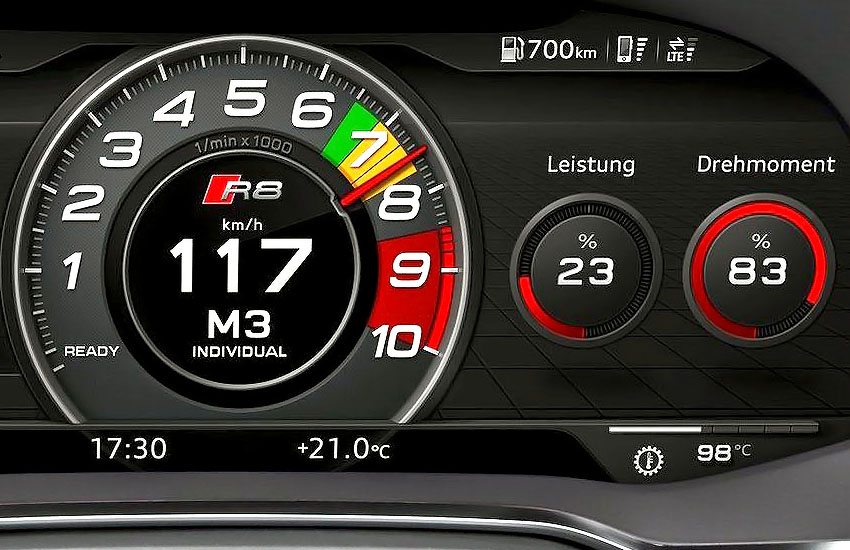You know those little dials and numbers on your car’s dashboard? They’re called gauges, and they’re like your car’s way of talking to you. Each gauge tells you something important about how your car is doing. You might see a speedometer, which shows how fast you’re going.
The fuel gauge tells you how much gas is left in the tank. Then there’s the temperature gauge, which keeps an eye on how hot your engine is getting. Some cars even have a tachometer that shows how fast the engine is spinning.
Knowing what these gauges mean can help you take care of your car and avoid problems on the road. Let’s dive into what each gauge does and why it’s important to pay attention to them.

What Do the Different Gauges in a Car Indicate?
Speedometer: How Fast Are You Going?
The speedometer tells you how fast your car is going. It shows this in miles per hour (mph) or kilometers per hour (km/h). When you look at the speedometer, you can see if you are driving within the speed limit. It’s important to pay attention to this gauge because driving too fast can be dangerous and can get you a speeding ticket.
Tachometer: How Hard is Your Engine Working?
The tachometer shows how fast the engine is spinning. This is shown in revolutions per minute (RPM). When the RPM is too high, it means the engine is working very hard. If you see the needle going into the red zone, you should ease off the gas or shift to a higher gear. This helps keep the engine from getting damaged.
Fuel Gauge: How Much Gas is Left?
The fuel gauge tells you how much gas is left in the tank. It usually has markings like Full (F), Half (1/2), and Empty (E). When the needle is close to E, it means you need to get more gas soon. Running out of gas can leave you stranded, so it’s important to keep an eye on this gauge.
Temperature Gauge: Is the Engine Too Hot?
The temperature gauge shows how hot the engine is. It usually has a cold (C) and hot (H) marking. When the needle is in the middle, the engine is at a normal temperature. If the needle goes to H, it means the engine is too hot. This can be a sign of a problem like a coolant leak. If this happens, you should stop the car and let it cool down.
Oil Pressure Gauge: Is the Engine Getting Enough Oil?
The oil pressure gauge shows if the engine is getting enough oil. Oil is important because it keeps the engine parts moving smoothly. If the oil pressure is too low, it means the engine is not getting enough oil, which can cause damage. If you see the oil pressure light come on, you should check the oil level and add more if needed.
Battery Voltage Gauge: Is the Battery Charged?
The battery voltage gauge shows how much charge is in the car’s battery. If the battery voltage is low, it means the battery might need to be charged or replaced. This gauge can help you know if there is a problem with the car’s electrical system. If the battery dies, the car won’t start, so it’s important to make sure the battery is always charged.
Odometer: How Far Have You Traveled?
The odometer shows how many miles or kilometers the car has traveled since it was made. This is useful for keeping track of maintenance and knowing when to get the car serviced. For example, you might need to change the oil every 3,000 miles or get new tires after 50,000 miles. The odometer helps you know when these things are due.
These gauges help drivers monitor the car’s health and performance while on the road.
Troubleshooting Common Problems
Sometimes, you might notice a gauge showing something unusual. Let’s look at some common problems and what to do about them.
Speedometer Not Working
If your speedometer isn’t working, it can be hard to know how fast you’re driving. Here are some steps to fix it:
- Check the Speed Sensor: The speed sensor tells the speedometer how fast the car is going. If it’s broken, the speedometer won’t work.
- Look at the Wiring: Sometimes, the wires connected to the speed sensor can get damaged.
- Visit a Mechanic: If you’re not sure what’s wrong, a mechanic can help fix it.
Tachometer Showing High RPM
If the tachometer is showing high RPM, it means the engine is working too hard. Here’s what you can do:
- Shift to a Higher Gear: If you’re driving a manual car, try shifting to a higher gear.
- Ease Off the Gas: If you’re pressing the gas pedal too hard, try easing off a bit.
- Check the Engine: If it keeps happening, there might be a problem with the engine.
Fuel Gauge Stuck on Full
If the fuel gauge is stuck on full, you won’t know how much gas you really have. Here’s what to do:
- Check the Fuel Sending Unit: This part tells the fuel gauge how much gas is in the tank. If it’s broken, the gauge won’t work.
- Look at the Wiring: Sometimes, the wires connected to the fuel sending unit can get damaged.
- Get Help from a Mechanic: If you’re not sure what’s wrong, a mechanic can help fix it.
Temperature Gauge Reading Hot
If the temperature gauge is reading hot, the engine might be overheating. Here’s how to fix it:
- Check the Coolant Level: Coolant helps keep the engine cool. If it’s low, add more coolant.
- Look for Leaks: Sometimes, there might be a leak in the coolant system. Check for any puddles under the car.
- Stop the Car: If the engine is too hot, stop the car and let it cool down before driving again.
Oil Pressure Gauge Showing Low Pressure
If the oil pressure gauge is showing low pressure, the engine might not be getting enough oil. Here’s what to do:
- Check the Oil Level: If the oil level is low, add more oil.
- Look for Leaks: Sometimes, there might be a leak in the oil system. Check for any oil spots under the car.
- Check the Oil Pump: The oil pump helps move oil through the engine. If it’s broken, the engine won’t get enough oil.
Battery Voltage Gauge Showing Low Voltage
If the battery voltage gauge is showing low voltage, the battery might be low on charge. Here’s how to fix it:
- Charge the Battery: Use a battery charger to give the battery more power.
- Check the Alternator: The alternator helps charge the battery while you drive. If it’s broken, the battery won’t charge.
- Replace the Battery: If the battery is old or damaged, you might need a new one.
When to Get Help
Sometimes, fixing car problems can be tricky. If you’re not sure what’s wrong or how to fix it, it’s always a good idea to get help from a mechanic. They have the tools and knowledge to diagnose and fix car problems safely and correctly.
Keeping Your Car in Good Shape
Regular maintenance is key to keeping your car running smoothly. This includes things like changing the oil, checking the coolant, and making sure the battery is charged. By taking care of your car and paying attention to the gauges, you can catch problems early and avoid bigger issues down the road.
Gauges in your car help you understand how your car is doing. If you notice a problem with a gauge, take action to fix it. Regular maintenance and paying attention to your gauges can keep your car running well and keep you safe on the road.


